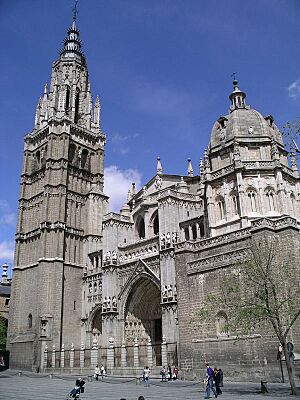Treatise of Garcia of Toledo facts for kids
The Treatise of Garcia of Toledo is an old book from the 11th century. It's also known by longer names like Tractatus Garsiae Tholetani canonici de Albino et Rufino or The Translation of the Relics of Saints Gold and Silver. This book was written to criticize the bad behavior and corruption of the Roman curia, which was the Pope's main group of advisors and officials.
The Treatise describes how the Pope, his cardinals, and his team were always feasting. It's a funny and critical story, a bit like a satire, based on a real visit. This visit was made by Bernard of Toledo, who was the Archbishop of Toledo, to Rome in May 1099.
A Secret Message
In the Treatise, Bernard de Sedirac is called "Grimoard." He travels to Rome to offer the Pope, Urban II, some special items. These items are called "relics" and are supposedly from "Saints Albinus and Rufinus." In return, Grimoard wants to become the Pope's special representative, or Papal legate, for a region called Aquitaine.
But here's the clever part: Albinus and Rufinus are not real saints! They are actually silver and gold. This was a medieval joke about bribery, meaning Grimoard was trying to give money or gifts to get what he wanted.
Making Fun of Feasting
The book makes fun of how much the Pope and his cardinals ate and drank. It describes them as people who loved food and drink too much. The author says they were capable of amazing amounts of overindulgence. For example, it says: "So, when this fattest of popes had tasted three or four draughts, as though by necessity, the cardinals emptied the bowl after him... Then once again Bacchus filled the golden bowl!" This shows how the author used humor to criticize their behavior.
Who Wrote It?
No one is completely sure who wrote this book. It's an anticlerical text, meaning it was against the power and influence of church leaders. In the book, the author claims to be Garcia of Toledo, a canon (a type of priest) from the church.
Some experts believe the book was written by someone who supported Henry IV, Holy Roman Emperor and the antipope Guibert of Ravenna. These were people who were against Pope Urban II. Other scholars think Garcia of Toledo might have been exactly who he said he was: a Spaniard who happened to be with the Archbishop of Toledo during his visit to Rome. As Rodney M. Thomson, a historian, pointed out, only a Spaniard would have thought Bernard's visit to Rome was important enough to write a whole funny story about it.
See also
 In Spanish: Garcineida para niños
In Spanish: Garcineida para niños


